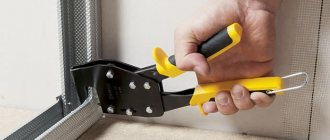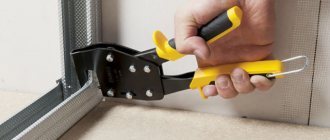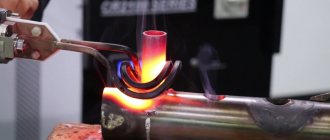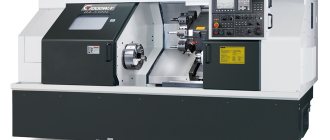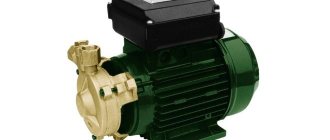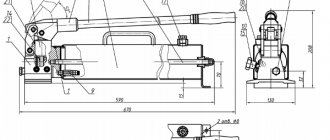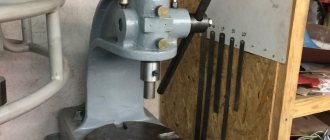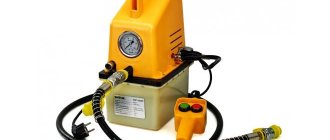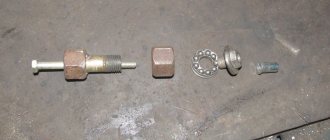| Place | Name | Characteristics in the rating |
| TOP 10 best profile cutters |
| 1 | BISON “MASTER” | The best tool steel |
| 2 | SIBIN 313 | A simple tool at an attractive price |
| 3 | Matrix 87951 | High quality lever system |
| 4 | DEXX 31391 | Best price |
| 5 | STAYER "GRAND" | The most reliable design |
| 6 | Enkor 300mm | Strengthened system |
| 7 | Sibin | A cutter with an enlarged mouth |
| 8 | Bison 3135 | The most convenient one-handed model |
| 9 | Brigadier | Presence of a rotating head |
| 10 | Knipex KN-9042250 | The best choice |
A cutter is a tool that allows you to quickly connect metal profiles to each other without using additional fasteners. The principle of its operation is to punch holes at the joints and simultaneously roll the edges. Thanks to this technique, we get a durable structure for drywall, and the main advantage of such fastening is the speed of construction.
When choosing a cutter for a profile, you should pay attention to the following factors:
- steel quality;
- reliability of the mechanism;
- ergonomics of handles;
- the presence of a lever mechanism, or its absence;
- punch size.
Most aspects are easy to determine by eye, except for the build quality and the steel used. You can’t do this without personal experience or reviews from real users. We also studied them and took them into account when compiling our rating, which included the 10 best models with which you will not experience any inconvenience when working. The TOP included both the most popular manufacturers, who often inflate the price just for their name, and little-known brands from Asia, which are also distinguished by their high quality and compliance with all stated requirements. We will look at both cutters with a reinforced punch and the simplest lever-type tools, which cost less, but are less convenient during operation and force the master to exert increased effort when pressing the levers.
Pros and cons of using cutters
This type of instrument is not very popular yet. It’s difficult to name the reasons, because the thing is really good. Especially for those who install plasterboard systems, and for home craftsmen, this is also a necessary thing. What are the advantages:
Yandex.RTB RA-1479455-7
- Fast and reliable connection of profiles. The speed of installation of the frame under drywall increases significantly. The principle of operation is simple: insert the parts to be connected between the jaws, squeeze the handles, move, repeat. And so on as many times as required. Punch for drywall profile. This is also what this instrument is called.
- No need to use fasteners. This saves time and money.
- The tool is hand-held, so no electricity is needed. You can work on any objects.
- There is no protrusion at the junction of the profiles. When mounted with rivets or self-tapping screws, the head protrudes above the surface of the profile. Self-tapping screws have more, rivets have less. This prevents the sheet of drywall from laying flat without bending. When using a cutter, the bends remain on the “wrong” side of the profile. The front is obtained without protrusions. The sheet lays flat, which reduces the time for putty and its consumption.
For installing drywall, the absence of protrusions is definitely a plus
Yandex.RTB RA-1479455-3
Few of those who have tried to work as a cutter return to self-tapping screws. Although, I must say, there are some. Sometimes in difficult places, the connection is “grabbed” with a self-tapping screw, then a cutter is used, and the self-tapping screw is unscrewed. But these are those who like to play it safe. With some work skill, additional fixation is not required.
Flaws
Now about the cons. Using a plasterboard profile cutter really saves time. But the tool is manual and requires the application of muscle force. With large volumes of installation, namely structures made from profiles, fatigue quickly accumulates. And by the end of the working day, the speed of work drops. The better the tool, the less effort is required, but it is still needed. And this is a minus.
The second drawback is the difficulty of disassembling. To separate the two profiles, you need to bend the metal petals. It takes more time than when unscrewing screws. But less than when removing rivets. It seems that these are all the difficulties and disadvantages of working with a cutter.
Not everywhere you can crawl up and make a cut. Then you have to use screws and a screwdriver
Yandex.RTB RA-1479455-8
There is another drawback, which is due to the shape of the working part. Some components - jumpers, clamps - are simply impossible to “reach” with a cutter. The punch won't fit in there. There are models with very large “windows”, but they are not very good for regular connections. For professionals, having several different models is normal, but for home use it is clearly overkill.
Self-tapping screws or notches
It has already been said that when using cutters the sheet lies flatter. And this is a clear plus in favor of the expanded connection. The second unconditional plus is saving time. The third is the lack of consumables.
The disadvantages of joining GK profiles with a cutter include insufficient fastening strength. Self-tapping screws are more reliable. Perhaps, but the strength of the frame is needed only until it is sheathed with gypsum boards. And it will be enough, even if you make only one fastener for each connection. But it’s up to you to decide which is better - a cutter or self-tapping screws.
How to choose a cutter for a metal profile
Perhaps the most difficult thing is choosing a specific cutter model. They are divided, as usual, into household and professional. The difference in price is more than noticeable. The cheapest and most acceptable quality ones can be purchased for about $10, normal ones from $20-30, and really good ones can cost $100 or more.
Profile cutter for drywall: which one to choose
What is the difference? In work resource and ease of use. This means that the more expensive ones use more durable and expensive metals, rubber and plastic for handles, etc. They have a more complex design of the working part; there is a mechanism that reduces the force required for connection. In general, there is something to pay for. But nevertheless, for periodic work, for the home, you can find quite good and functional specimens in the cheap segment.
The difference in the working part between a regular inexpensive cutter and a professional
When choosing a cutter for a profile from any category, look at the following parameters:
- Maximum thickness of fastened parts. Please note that the total thickness of metal that this tool can penetrate is indicated. That is, if 1.2 mm is indicated, this means that you can take two sheets of 0.6 mm or 0.8 mm + 0.4 mm, but not two sheets of 1.2 mm.
- Shape and size of the “window”. Rounded corners make work easier.
- The presence of a roller that pushes the punch. Such models are more expensive, but require much less effort.
- The case is free of defects, cavities, cracks, massive and heavy.
- We evaluate ergonomics. The handles should be comfortable, with stops.
- It is ideal if the handles have rubberized inserts. Otherwise, you will have to work with gloves - there will be calluses.
- The handles can be grasped with one hand when extended.
For professionals, such a tool is a godsend, but for amateurs and home craftsmen the price is too high
And it is very desirable that the company be well-known. Although, there are also nameless “Chinese” ones that are very good for home use.
Fasteners
Fixation of profiles to planes, as well as to each other, is carried out by products, which include:
- U-shaped bracket. A bent perforated metal plate, the purpose of which is to connect the frame being built with the walls and ceiling. To do this, the bracket is fixed to the surface to be finished in the middle, and a starting profile for drywall is attached to the ends;
- quick suspension It is used when a U-shaped bracket is not enough, and consists of 2 parts - a knitting needle with an eye at one end and the suspension itself. The parts of the product are attached to each other using a spring, which allows adjustment of the height of the suspension, which is the advantage of the element. This type of fastening has a drawback - after some time, the spring weakens, as a result of which the suspended ceiling may sag.
- crab connector. Makes it possible to fasten load-bearing profiles crosswise. To do this, the product is mounted in the profile, attached to it with antennae and self-tapping screws, after which a jumper is attached in a similar way, which is also fixed with self-tapping screws. To install one crab connector, it must be fixed with 8 self-tapping screws;
- CD connector. The purpose of the element is to lengthen the load-bearing profiles. To do this, they are inserted into the connector on both sides and fixed with self-tapping screws;
- two-level CD connector. A rare product used to assemble a frame attached to a wooden floor. The frame made using these fasteners turns out to be double: first, the first and then the second level of profiles are assembled, which is mounted in the usual way. The need to use a two-level connector lies in the need to compensate for changes in the size of the tree depending on the level of humidity and temperature changes.
Fastening metal profiles to surfaces, to each other, as well as screwing plasterboard sheets to them is carried out using piercing and drilling type self-tapping screws, equipped with nylon dowels, anchor wedges, and dowel nails.
Door (window) opening
If the partition has a door, then a gap of the appropriate length is made in the lower guide. Then they proceed according to the following scheme:
The racks adjacent to the doorway are aligned vertically using a level. They are attached with self-tapping screws to the frame guides and then reinforced with wooden beams.
- The upper jumper from the guide profile is installed. It should be located 1–1.5 cm above the future door structure.
- An additional vertical post, cut to size, is attached to the gypsum board joining line above the door.
The window opening in the partition is made in a similar way, only another horizontal lintel is added at the bottom.
Advantages
Ticks have significant advantages:
- Significant savings for large volumes.
- Energy independence. The tool can be used anywhere. Its action is purely mechanical.
- No need to make markings.
- Profiles are not subject to deformation.
- The holes are neat, with smooth edges.
- No additional tools (drill, screwdriver) are required to carry out the work.
- There will be no dents left on the frame.
With the help of a cutter, a hole is punched faster than a self-tapping screw is screwed in, and there is no risk that it will go far. Thanks to the profile pliers, the connections are reliable. If necessary, they can be easily disassembled.
Devices for carrying and maintaining drywall sheets
When working with drywall, it is not very convenient to perform some actions, since massive slabs often have to be moved from one place to another. Also, certain difficulties may arise in cases where it is necessary to hold the mounted material at a height. Special devices that are used by many professional craftsmen help cope with such tasks.
Carrying handles for drywall
There are models of carrying handles designed both for work in pairs and for one person. In the first case, a set of two handles is used, which allows you to grab the plasterboard at the required height and carefully move the material, holding it in the desired position with your free hand.
For work performed alone, a carrier made of plastic or metal is intended, due to the design of which the sheet is sufficiently securely fixed. This device is convenient to use at home if repairs are carried out without the involvement of assistants.
Three wheel trolley
To transport drywall on a large construction site, it is advisable to use a trolley on which up to 400 kg of material can be loaded. The length of such a device is usually about 1.2 m, and the width is at least 0.6 m. If it is necessary to transport sheets, they are installed on the edge, maintaining a small angle of inclination. It should be noted that the larger the diameter of the trolley wheels, the easier it is to transport through an area that has not been cleared of construction waste.
Mounting support
This tool for working with drywall is a device in the form of a lever located on a stand, which is equipped with a metal movable stop necessary to hold the material. In the process of covering walls, as well as creating niches and partitions, such a device ensures the vertical position of the sheet, which is attached to the profile. At the same time, the integrity of the lower edge of the mounted gypsum board is preserved.
Pedal lift
Allows you not only to quickly fix sheets during wall covering, but also to press drywall to the ceiling. However, it will be difficult to install drywall without the help of a partner, since such a design limits the movement of the master.
Frame lift
For some complex work, in particular those related to the installation of ceiling structures or ventilation elements, the ideal option would be to use a mobile device such as a frame lift. It can be used to move and install sheets in both vertical and horizontal positions. This tool for installing hypocardboard allows you to securely fix the material on the frame, which is especially convenient when creating continuous suspended ceilings. The lift is equipped with wheels, due to which the gypsum boards are moved almost effortlessly, which in turn has a positive effect on the quality of installation.
The total weight of such a device is usually about 26 kg. At the same time, it can be used in work performed at a height of up to 3 m. The maximum permissible weight of transported materials is 50 kg. With such a device at his disposal, one person can easily install sheets of drywall without involving assistants.
Some technical characteristics of models offered by different manufacturers may vary slightly. In addition, there is such a device as a spacer lift. It is mainly used when working with suspended ceilings.
With a limited budget, not every home craftsman can afford to purchase a special device. However, it will be quite difficult to efficiently install a solid suspended ceiling without auxiliary equipment. In this case, it makes sense to make two T-shaped supports yourself. The length of the stand of such a product is determined based on the height of the room, so that the material can be ensured a tight fit to the ceiling. Craftsmen successfully used such devices before the first lifts went on sale. A partner is expected to be present during the installation process.
Measuring tools for marking and dimensional control
High-quality installation of gypsum boards requires precise markings and preliminary measurement of the material. Classic tools include a tape measure, a level, and a plumb line. However, there are also many modern devices that can significantly speed up the process and achieve better results. Let's consider what devices are used by experienced craftsmen today.
Roulette
This is a well-known measuring instrument, the body of which is made of plastic or metal, and inside there is a measuring tape. Most often, tape measures 3 m long are used. However, to perform various long measurements, it is better to have a five-meter tape measure.
Level
This tool, used for working with drywall, allows you to control the slope of any vertical or horizontal surface. The product consists of a metal case with an ampoule built into it (there may be several of them), which is filled with an alcohol-containing liquid that has a certain color. The angle of the base or structural element is determined by the air bubble inside. With a perfectly flat surface relative to the ground, it should occupy a middle position, without going beyond the existing marks.
Modern manufacturers offer a variety of level models of various sizes. Their differences may lie in the number of built-in tubular indicators, as well as their location. Some products are equipped with magnets, which is convenient when aligning elements of metal structures. Particularly popular are devices with laser pointers, which allow marking to be made as quickly as possible.
Metrostat 300
A sliding tool equipped with a measuring scale and a bubble level, the length of which can reach 3 m. With its help, you can control the horizontal and vertical position of the structure. In addition, there is a special nozzle designed to hold the plasterboard in a vertical position during installation work.
Hydraulic level
Makes it possible to break down horizontal planes, as well as transfer marks from one surface to another. The hydraulic level is mainly used when working with suspended ceilings. The marking lines are determined using a hose, the length of which is usually at least 10 m.
Line laser level
With modern measuring technology, almost perfect results can be achieved. One of the devices widely used in working with drywall is a linear laser level (plane builder), which allows, using mutually perpendicular beams, to construct projections both vertically and horizontally, which makes it possible to perform high-quality markings of absolutely any plane.
Laser rotary level
This device, operating in different modes, allows you to set vertical, horizontal and inclined planes. The laser beam in such devices constantly rotates around its axis. Thus, it is capable of projecting a plane at 3600. These devices are convenient to use when working in large rooms.
Square
This tool is used primarily for marking corners. Structurally, the device is quite simple and consists of a ruler of a certain length, mounted in a metal base. It can also be used to control the rectangularity of certain elements.
Grinding tools
Grinding grater
The product in the form of a plate equipped with special clamps for replacing the mesh is used in the process of dry grinding of plasterboard sheets and seams treated with a putty mixture.
Grater with extendable handle
Here, in addition to the clamps, there is a handle, which is secured in a hinged manner. The tool is designed primarily for working in hard-to-reach places. If necessary, the handle can be extended independently, thus increasing the range of action. This will allow the technician to be away from the area with the most dust generation.
Vibratory grinders
These devices allow you to speed up the surface cleaning process, which is due to a fairly high vibration frequency. In addition, such devices are capable of absorbing dust that accumulates in a special dust collector.
If you notice an error, a non-working video or link, please select a piece of text and press Ctrl+Enter .
0
